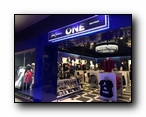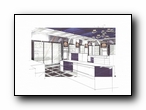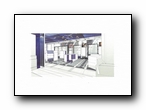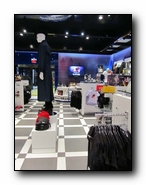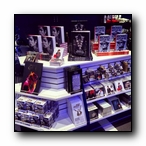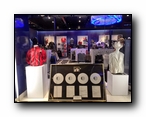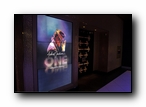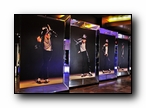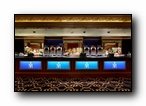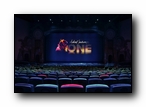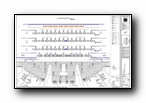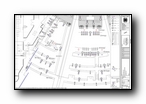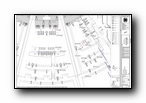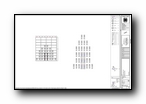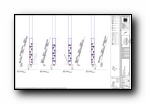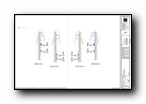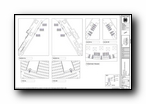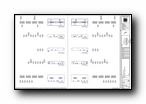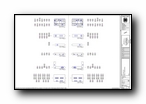
![]()
[ You are here: Grand Chapiteau | Creations | Michael Jackson ONE | Scénographie ]
Création
Expérience
Odyssey
Given the quality of his work and his reputation for high standards, the expectations for a show revolving around Michael Jackson will always be exceedingly high. Michael was a multi-faceted artist who like to fuse musical styles and art forms, but he never made forays into the world of theater per se, with the exception of the musical adventure film "The Wiz". Michael Jackson ONE, produced in conjunction with Jackson's estate, is the first large-scale production developed for the theater about the world and music of the King of Pop, and it aspires to meet the level of perfection the star would demand. The show, which combines Jackson's music with Cirque's distinctive acrobatic feats, is at the Mandalay Bay Resort and Casino in Las Vegas in a space that was formerly occupied by a production of Disney's The Lion King; it was completely renovated specifically for MJ ONE. CDS anchored a team that included Auerbach Pollock Friedlander, Moser Architecture Studio, and Jaffe Holden Acoustics for the design and specification of the rigging and automation, lighting control, and audio-video systems. "You take this sound system, combined with the immersion of an IMAX-like surround-sound theatre," The musical director, Kevin Antunes says, "then you take a story line that Jamie King put together, all the creative minds of Cirque, and Michael Jackson's music to create a truly unbelievable show!"
Séguin's first collaboration with writer-director Jamie King was a fruitful one. The entire team listened to a lot of Michael Jackson to really delve into the material and "find the spirit of the show." King came with a list of songs he wanted to include and from which the team created a musical structure. Each song had a theme, goal, or reference to famous video, and sometimes that meant that the scenic setup might determine the song order. According to Séguin, this created a kind of in-one structure to the puzzle of figuring out the show. "One of the defining principles of the design is to support fast changes without being literal. The proposed solutions were more like a Broadway show with traditional scene changes than some other Cirque projects," he says. The largest evolution of the piece came in the increasing introduction of Michael Jackson's image. Originally, the show was meant to evoke Michael's spirit, but as the show evolved, his physical image became more and more central to the design. This drastically shifted the video design, which, of course, had ramifications on the scenery, but the essential set design was already complete by the time these changes occurred. Much of MJ ONE resonates with Jackson's touring shows and his love of technology. The use of poplifts in this show is fitting, as is the automation and the state-of-the-art technology. "There are five poplifts," notes APF principal Tom Neville. "Each one can propel a performer high into the air, or it can also be used as a small standard lift to bring props and performers on stage in a less dynamic fashion. "There are also three large stage lifts that are used to bring large scenic pieces from the trap room area to the stage. These lifts, as well as all the stage machinery, are operated by the integrated stage machinery automation control system that has multiple control consoles positioned within the theatre. The dynamic acrobatic flying choreography is supported by acrobatic tracks with automated trolleys and individual winches over the audience. These winches are controlled by the same system that controls the large lifts, poplifts, and other stage machinery, so the interdependent timing between all moving elements is flawless." The automated rigging system includes two "winch farms" with individual control of up to 59 motorized winches. An automated trolley system with individual winches flies performers and scenic elements over the audience. All of the automation is networked using one of three fiber-optic networks that synch the automation, lighting, and audio-video systems. Each system also has a redundant backup using RAID-1 hard drive arrays. The automation controls, winches, tracks, and trolleys were supplied by Stage Technologies, and the stage lifts were supplied by handling specialties. The structural engineering was handled by Englekirk Structural Engineers, and the mechanical/electrical/plumbing engineers were JBA Consulting Engineers, and they also handled life safety engineering.
Jonathan Deans designed the audio system along with Auerbach Pollock Friedlander principal Paul Garrity and senior associate Dan Mei. The main front-of-house sound reinforcement and effects play back through a computer controlled audio matrix and processing system with 120 inputs into 120 matrix outputs. It has modular control surfaces for live mixing and routing control of microphones and multi-track audio playback. There is also a secondary 48 x 48 channel audio console and processing system for performer in-ear and stage loudspeaker monitoring. Audio is distributed using a redundant fiber loop transport system with microphone preamps. It routes all the front-of-house, performer-monitoring, and back-of-house audio using recallable matrix presets. A network server allows on-the-fly routing and also provides a means of backup. There are 16 channels of wireless microphones, 16 channels of stereo in-ear monitoring, two channels of IFB, and 40 wireless receivers. In recreating Jackson's signature sound, Deans had to respect the demographics of the audience, from five to 95 years old. "I had to be careful of the sound levels. How loud is too loud? From Cirque's side, too loud; from the rock side, not loud enough—it's a delicate balance." The audio in Michael Jackson ONE doesn't overpower the rest of the production, but it blends well. It's not exceedingly loud, and there are no gratuitous 3-D effects, just great quality sound that you would expect from a live concert. And there's a very good reason for that. "This one is very much like attending a concert with Michael Jackson," Deans notes. "I really want you to feel as if you're at a great concert. We're not standing there screaming and lighting lighters but a very elegant concert." This experience is aided by the quantity of the audio components. Deans placed three speakers in each seat - 5,412 custom left-center-right speakers divided into 24 zones - like he did at LOVE, but this time, his goal was to help create an arena kind of feel, rather than an in-your-head sound. In addition to speakers in the seats, there's a total of 175 Meyer Sound loudspeakers in a very large surround system on the walls of the theater, which include 16 Galileo 616 processors for system control, 24 Micas for left-right array, 38 JM-1Ps for the center cluster, and 12 1100-LFC low-frequency control elements. The FOH console is a Meyer Sound D-Mitri digital audio platform, with 120 inputs and 120 outputs at 96kHz, all connected digitally on a fiber-optic Optocore backbone. Solotech provided the gear and installation, and the system is cared for by Cirque du Soleil's audio head Aaron Beck and his crew. The Meyer Constellation system with 41 microphones and 144 speakers is used to create 17 user presets with maximum room reverb time of 4.5 seconds. "Constellation is used very heavily to create the concert feel, and the space and depth and dynamics of the music and the room itself," explains Deans. "When the audience applauds and cheers, it sounds as if they are in an arena. This is a concert-style performance, so you believe that's where you are. We wanted to enhance the concert experience, recreate a concert atmosphere in a theatre, which is more complicated than concert sound. In my world, I don't want to make sound simply loud enough to be heard. There has to be other motivation for it." Playback is via MOTU Digital Performer 8 on dual Apple Mac Pros with RME HDSPe MADI FX PCI Express cards running 64 channels each. "Musical director Kevin Antunes would make a mix in the control room and bring it into the theatre, and we would collectively listen to it," says Deans, who worked closely with playback engineer Glenn Erwin and associate sound designer Brian Hsieh. "Most of the mix elements and movement were done in DP, then fed to the Meyer LCS system to take over and extend it further." Everything is playback, with just two live performers, a female singer and a female guitarist. "The singer is generally flying in the air; she never sings on the deck," explains Deans. "The guitarist is on stage. Both are incredible. The guitarist worked with Michael Jackson's guitarist for an authentic sound. In fact, she is so good that people thought she was miming, so she changes a few things to let people know she's live." The main arrays and downfills are Meyer Sound MICA, M'elodie, and UPJ-1P speakers; overhead are Meyer JM-1Ps and MTS-4As. The subs are Meyer 1100-LFCs. Surround speakers include Meyer MSL-4s, UPQ-1Ps, UPJ-1Ps, MICAs, M'elodies, and M1Ds. Providing front fill are Meyer M1Ds. Audio is processed through a Meyer Galileo system; the power amps include Crown CTS-3000, CTS-2000, and CTS-4200 units. The audio is distributed throughout the venue in digital form using a fiber-optic backbone powered by an Optocore 2 Gbps network with 496 inputs and 700 outputs. There is a total of 19 devices in the ringed network, including one server computer and six client computers. Among the networked devices is a Meyer Sound D-Mitri digital audio platform, which processes and distributes audio signals. The front-of-house audio console is a Yamaha DM 2000 with six Optocore Y3R-TP audio interface I/O cards, which allow 96 inputs and 96 outputs at 48kHz. Optocore provided custom sample rate converters to maintain its fiber network rate at 96kHz, while the Yamaha consoles run at 48kHz to keep the full channel count. There is also a Meyer Constellation electronic acoustic system, designed to enhance and augment the room acoustics. It provides the ability to alter the reverberation time and delay characteristics in real time using a 48 x 72 routing matrix and digital signal processors. The audio coup de grâce is the personal 3.0 speaker system built into each seat, with left and right speakers built in and another speaker embedded in the seat directly in front. The main speaker arrays are hidden behind acoustically transparent material in the 64'-wide proscenium, while the subwoofers and surround sound speakers are rigged in the catwalks. "It's surround sound," Deans says, "but we make our own format, like in LOVE. In fact, during one of the sessions of LOVE, someone said, ‘What format is it?' I said, ‘I don't know because I don't work in formats; I work with what's needed for the production.' The format is not a format because every single moment, and certainly every single song, has a different way of coming to you. It's not something that is fixed because if it is fixed, that's a movie. Movies have formats because they need to go from one movie house to another. It has to be something very fixed so that you can plug in and off you go. We're not interested in that. The only way you can hear Michael Jackson ONE is by coming here. There's nowhere else you can hear it, any of the music, in the same way."
"Our mandate was to create a theatrical performance," says David Finn of the lighting design for MJ ONE. "Jamie King had just finished the touring version of Michael Jackson: The Immortal World Tour, which was a true concert-style performance, and both he and [Cirque du Soleil founder and CEO] Guy Laliberté were keen to create a piece that had a theatrical arc story-wise, musically, and visually. Jamie comes from the pop world, so I knew that he would want to turn to them at some point and say, ‘Let's just blow this number out, have a good time, and make a pop number inside of this little story that we built.'" So Finn went for the flexibility of a repertory theatre plot, along with arrays of fixtures in key positions that could fill the space with stunning visuals. PRG, A.C.T Lighting, 4Wall Entertainment Lighting, Solotech, and Entertainment Lighting Services provided the gear. The main fixture he chose was the Clay Paky Alpha Profile 1500. "It's sort of the workhorse of the production," he says. "There are over 100 of them in the show." To be exact, there are 100 Alpha Profile 1500s and ten Alpha Profile 1200s. "We filled the Alphas with probably one of the largest, most diversified gobo catalogs ever used in one show," notes Finn, adding that "the Alphas fill the space—FOH, cats, box booms, over forestage, on all four electrics, and on a boom set-up that includes a 20'+ high number one boom that rolls on and offstage as we wanted to have it fully exposed for some of the more rock sections of the show." This provided Finn with the flexibility he was looking for. "I knew that there were 27 production numbers in 90 minutes," he says, "and that I would need a lot of choices." Clay Paky's Sharpy was Finn's choice for key placement for rock ‘n' roll arrays. "We lined them up on four flying ladders at the rear of the space, as well as fill the number one electric and booms with them, essentially building a grid that could fill the proscenium opening," he explains. "We finished by placing them in a forestage trough and two niches left and right, cut into the side stages that wrap into the house. These units provide great air looks and act beautifully for forestage shins." The overheads were filled out with 18 Alpha Wash 1200s that were picked up from another Cirque show and refurbished. No rock-and-roll show would be truly complete without lasers, so a 25W LaserNet RGB and two 20W LaserNet RGB units were programmed into the show, requiring careful calibration of projection zones for the audience and video projectors. And since this is 2013, it wouldn't be a rock-and-roll show without LED fixtures. "Integrated into the set pieces," Finn says, "we found this fixture that fell into our lap at the last minute called the Rosco Miro Cube. It's a 4"-by-4" cube, and it's RGBW LED with a variety of lenses that you can use. It was a perfect size, perfect brightness, perfect color, perfect dimming, everything, for this show. We have around 250 of them all throughout the set pieces, in trenches, and all over." One of the more notable lighting technologies involves the custom LED elements, especially in the costumes. It took nearly six months of tedious work to program the LEDs in the costumes and the set. RC4 Wireless placed DMX receivers on the moon to dim the custom-LED star sticks, inside the translucent moon for internal lighting, and on a prop stool to control the start and stops of motorized props. Receivers also dim the custom RGB LED panels and LED MR16 Par20 fixtures lighting the elephant during the "Elephant Man" sequence while dimming RGB Philips Color Kinetics iColor Flex fixtures and controlling a Look Solutions Viper NT on The Muse's platform. "When we mention that we had over 7,000 LEDs, we feel like we've earned the right to brag a bit," Hind says. "Because of the complexity of the pieces, we ended up programming most of those 7,000 LEDs individually." Assistant lighting designer and project manager Josh Hind coordinated the plot and equipment, as well as designed positions and supervised the theatre's renovation. "I would be remiss if I didn't mention the lighting cue count," says Hind, "which, when I left the theatre, was at 13,551. Our programmer, Benny Kirkham - who was, coincidentally, the Vari-Lite programmer for Michael Jackson in the '90s - says this is probably the most complex programming ever done on the [MA Lighting] grandMA. "The ‘Billy Jean' number alone probably took two months to program," Finn says. "He had to start out by mapping all the LEDs, and some of the costumes had 300 or 400 LEDs in them. And then if I said, ‘I want the thing to go blue from head to toe, he would have to make sure he had the mapping in the right order and know whether the arms were up or down, if the leg is out or in … It was crazy!" But the lighting adds to the emotion of the show in a big way.
The video design took a large team of talented designers working extremely quickly for MJ ONE. Longtime collaborators Raymond St-Jean and Jimmy Lakatos led the team, which needed to roll with the punches while creating complicated and riveting imagery. While Lakatos considers his purview to be "video scenography," St-Jean designs the images and graphic language of the piece. "My skill is more to make sure the integration of the content will be efficient," Lakatos says. St-Jean and Lakatos brought in collaborators at Fly Studio, including Jean-François Talbot, to generate the actual imagery and content. When they came on board, St-Jean and Lakatos worked with set designer Francois Séguin, who had already designed a lot of black surfaces and, as Lakatos says, "that was the first thing we needed to rethink." Because the show was to be created with projectors (rather than LED scenery), the designers had to keep contrast ratio in mind throughout the process. Lakatos explains that LED walls have other problems. "More and more in rock shows today, we use LED screens," Lakatos says. "And they are so powerful that they light the entire stage." It was a challenge, he adds, to strike a balance between the light on the stage and the brightness of the video. "Normally, Jamie King is used to working with the power of video walls, but, in this case, he needed to rethink how we needed to show the images with less power." The designers had one factor in their favor, however, and that was time. They used it to set up gear on the stage, measure light levels, and evaluate the effectiveness of video projection as opposed to an LED video wall. "We're at around 30fc in this show. Normally, we work at around 50 or 60. We needed very, very high contrast." The resulting system uses a total of 16 Christie Roadster HD-20K projectors for the main projection plus six HD6K-Ms, three HD10K-Ms, one Roadster HD-20K, and one Roadie HD35K for various specials. Content was developed using a variety of software tools, including Autodesk SoftImage (3-D animation and visual effects software), Blue Newt, and Adobe After Effects. The original design of ONE was meant to "evoke the presence of Michael," but both the Jackson estate and the creators of Cirque du Soleil really felt that there needed to be a more palpable presence of Michael. From the beginning, the end of the piece was meant to culminate in a Pepper's ghost effect, which would conjure Jackson dancing with the live performers onstage. But eventually, footage from Jackson's videos also became part of the video design of ONE. Lakatos says Fly Studio owner Jean-François Talbot was very involved in creating video content for the project and spent time with them in Vegas. As ideas developed, Lakatos and St-Jean worked with words and images to create the visual language of the piece with King. Then they worked with 2D illustrators and guided them through many images. As St-Jean explains, "Once we get the image that is pretty close to what we want, we take the illustration to the 3D animators to do modeling. We cannot start 3D animation without being sure of what we want to do." Because the whole show was set to Jackson's music, the design could be time-coded, which made it easier for the motion-graphic animators. According to St-Jean, they had to "find ways to integrate [Michael] into numbers." The original design for "Smooth Criminal," for example, had 3D animations of buildings with just a silhouette of Michael, but the team ended up using the original music video imagery in the onstage "billboards" in projected scenery. They had to figure out ways to put Michael into the existing edit as though it was planned. Says Lakatos, "Our goal was making sure that the content could be integrated into our scenery." The projection and video team uses various projectors from Christie: 16 Roadster HD20Ks, six HD6K-Ms, and three HD10K-Ms; a Roadster HD20K and a Roadie HD35K for specials, along with the Daktronics LED wall, five Samsung LED flat-screen TVs, and seven other LCD TVs. The system runs via 12 VYV Photon media servers controlled by a VYV controller. Lakatos is a big fan of the VYV system, which he first used on the Timberlake show and allows him to use realtime 3D mapping. He calls it his "realtime paint box—just amazing—able to do anything you want." They also collaborated with video designer Dago Gonzalez, and Lemieux a nd Pilon, who created the Pepper's ghost effect. Technomedia Solutions p rovided the gear. |


